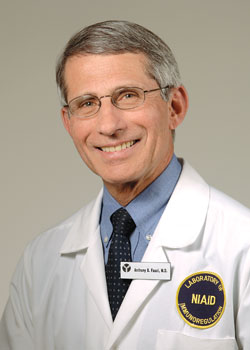Para su vida: Prevención y tratamiento del VIH y el SIDA

La periodista de orígen cubano, Cristina Saralegui, es adorada por su programa de televisión en Univisión, como también por sus numerosos esfuerzos filantrópicos.
Foto/Photo: Alianza Nacional para la Salud de los Hispanos / National Alliance for Hispanic Health
Cuban American journalist Cristina Saralegui is beloved for her Univision talk show as well as her prolific charitable efforts.
Desde que empezó la epidemia de VIH y SIDA a principios de la década de los ochenta, los hispanos, tanto hombres como mujeres, han sufrido una incidencia mayor de estas enfermedades que otros sectores de la población estadounidense. En este artículo le ofrecemos información básica sobre prevención y tratamiento.
Ya sea que se encuentre haciendo giras a través del país o haciendo reportajes en su programa de televisión, la popular periodista Cristina Saralegui tiene un mensaje muy claro que transmitir.
"Es esencial que todos los hispanos entiendan que existen maneras de prevenir y tratar el VIH y el sida. Debemos informarnos y educar a nuestros hijos para que las nuevas generaciones no tengan que sufrir tanto como las actuales".
Saralegui participa en diversas campañas de salud, y tiene particular interés en llevar estos mensajes a los jóvenes hispanos de los Estados Unidos.
Desde que se reportó el primer caso de sida en los Estados Unidos en 1981, la enfermedad se ha convertido en una epidemia a nivel mundial. El sida es en realidad un grupo de enfermedades, causadas por el virus de inmunodeficiencia humana (VIH), que atacan al organismo porque el sistema inmunológico (que es el que le permite luchar contra las infecciones) deja de funcionar adecuadamente. Estas enfermedades (llamadas "infecciones oportunistas"), que rara vez se desarrollan en individuos con un sistema inmunológico saludable, pueden poner en peligro la vida de una persona con sida.

El Dr. Anthony Fauci recibió este año el premio VIDA de la Alianza Nacional para la Salud de los Hispanos (la Alianza), por su incansable labor en la lucha contra el VIH y el SIDA. El Dr. Fauci es director del Instituto Nacional de Alergias y Enfermedades Infecciosas (NIAID) , una entidad de los Institutos Nacionales de la Salud (NIH).
Foto/Photo: NIH/NIAID
Dr. Anthony Fauci, M.D., received the 2008 VIDA Award from the National Alliance for Hispanic Health for his tireless work in the fight against HIV and AIDS. Dr. Fauci is Director of the National Institute of Allergy and Infectious Diseases at the National Institutes of Health.
Una vez que el VIH agota el sistema inmunológico, la "inmunodeficiencia adquirida" hace que los pacientes se vuelvan vulnerables a muchas otras enfermedades, en particular diversos tipos de cáncer, como el cervical entre las mujeres, el sarcoma de Kaposi y los linfomas (que atacan el sistema inmunológico en sí). Además, el cáncer suele ser más agresivo y más difícil de tratar entre los pacientes de sida.
Actualmente, el número de hispanos con VIH o sida en los Estados Unidos, asciende a más de 84,000, y la tasa de infección en este sector de la población es 2.5 veces mayor que entre los blancos no hispanos. El Dr. Anthony S. Fauci, director del Instituto Nacional de Alergias y Enfermedades Infecciosas (NIAID), una entidad de los Institutos Nacionales de la Salud (NIH), sostiene que "es necesario reducir, de manera drástica, la tasa de VIH y sida en todos los sectores de la población estadounidense". El NIAID es el principal organismo de los Institutos Nacionales de la Salud dedicado al estudio del VIH y el sida, y se encuentra a la vanguardia en la lucha contra esta continua crisis sanitaria. El Dr. Fauci, que ha dirigido el NIAID desde el inicio de la epidemia del sida, ha sido galardonado este año con el premio VIDA (por sus iniciales en inglés: Vision, Innovation, Dedication, and Advocacy) por la Alianza Nacional para la Salud de los Hispanos, conocida también como "la Alianza".
Datos Importantes
- La tasa de infección por VIH es 2.5 veces mayor entre los hispanos que entre los blancos no hispanos.
- Más del 25% de los casos de VIH que se diagnostican en los EEUU. son mujeres.
- No existe una cura ni una vacuna para prevenir el VIH o el sida, pero la detección temprana mediante la prueba del VIH, así como los tratamientos actuales, extienden considerablemente tanto la expectativa como la calidad de vida de los afectados.
- La línea de asistencia telefónica Su Familia (bilingüe en inglés y español), a través del número 1-866-783-2645, le ofrece información sobre estas enfermedades, así como una lista de profesionales de la salud que puede consultar en su área y remisiones para hacerse la prueba del VIH.
HIV/AIDS: Prevention and Treatment for Life
Since the beginning of the HIV/AIDS epidemic in the early 1980s, more than 80,000 Hispanic men and women in the United States have died from the disease. Here's what you need to know about preventing and treating HIV and AIDS.
Whether popular Cuban-American television host and journalist Cristina Saralegui is traveling to speaking engagements across the country or reporting on her television show, her message is clear.
"It is very important that all Hispanic Americans understand that there are ways to prevent and treat HIV and AIDS," she says. "We must all work to educate ourselves and our children about these diseases so that future generations will not have to suffer as so many people do today."
Saralegui is involved in a variety of health and wellness causes, and she is especially interested in bringing these messages to young Hispanics in the United States.
Since AIDS was first reported in the United States in 1981, the disease has become a major worldwide epidemic. AIDS refers to a group of illnesses that result from being infected with the human immunodeficiency virus (HIV). These illnesses develop because our immune system (our body's mechanism for fighting off infections) can no longer do its job. As a result, the body becomes vulnerable to a variety of illnesses, called opportunistic infections. Some of these infections can be life threatening for a person with AIDS. They are rarely seen in individuals with healthy immune systems.
When HIV has depleted the immune system, the "acquired immune deficiency" causes patients to be vulnerable to many other diseases. People with AIDS are also particularly prone to developing various cancers, especially those caused by viruses such as Kaposi's sarcoma and cervical cancer in women, or cancers of the immune system known as lymphomas. These cancers are usually more aggressive and difficult to treat in people with AIDS.
More than 84,000 Hispanics are living with HIV/AIDS and the rate of new HIV infections among Hispanics is 2.5 times greater than among non-Hispanic whites.
"Nationally, we must dramatically lower the rate of new HIV infections among all populations," says Anthony S. Fauci, M.D., Director of the National Institute of Allergy and Infectious Diseases (NIAID) at the National Institutes of Health (NIH). NIAID is the lead institute for HIV/AIDS research at NIH and is at the forefront of the effort against this continuing health crisis. Dr. Fauci, who has led NIAID since the earliest days of the AIDS epidemic, is the recipient of the 2008 VIDA (Vision, Innovation, Dedication, and Advocacy) Award from the National Alliance for Hispanic Health (the Alliance).
Fast Facts
- The rate of new HIV infections among Hispanics is 2.5 times greater than that for non-Hispanic whites.
- Women account for more than a quarter of new HIV diagnoses in the U.S.
- There is no cure or vaccine to prevent HIV/AIDS, but early detection through HIV testing and treatment greatly extends years and quality of life.
- Information, including referral to HIV testing and health providers in your community, is available by calling the bilingual Su Familia helpline at 1-866-783-2645
Lea más sobre / Read more about "Nota de Tapa: el VIH y el SIDA / Cover Story: HIV/AIDS"
Para su vida: Prevención y tratamiento del VIH y el SIDA / HIV/AIDS: Prevention and Treatment for Life
Síntomas, diagnóstico, tratamiento / Symptoms, Diagnosis, Treatment
NIH: De la investigación a los resultados / NIH Research to Results
Winter/Invierno 2009 Vol. 1 No. 1 Pag. 16 - 19
